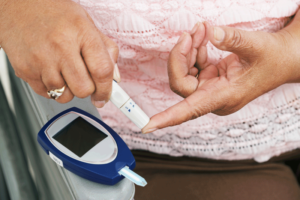
Five Types of Diabetes?

Do you or someone you know suffer from diabetes? If so, you’re not alone: it’s the fastest-growing disease worldwide. Until recently, the disease has been classified into two types. Type 1, or early-onset diabetes, is the kind that people are born with. Type 2, or late-onset, develops over time. But scientists have now discovered that this classification system is out of date. Instead of looking at just age and glucose levels, scientists are now considering six important variables: age; body mass index (BMI); presence of beta-cell antibodies; level of metabolic control; measures of beta-cell function; and insulin sensitivity. Based on their research, they discovered that there are actually five different, genetically-distinct types of the disease:
- Severe Auto-Immune Diabetes (SAD): includes what was previously known as Type 1 diabetes
- Severe Insulin-Deficient Diabetes (SIDD): may arise in patients with low BMI; includes lack of insulin; appears early in life; diabetic eye disease is common
- Severe Insulin-Resistant Diabetes (SIRD): linked to high BMI; cells don’t respond to insulin; high risk of chronic liver and kidney disease; benefits the most from metaformin
- Mild Obesity-Related Diabetes (MOD): linked to high BMI; can be managed with metaformin and lifestyle improvements
- Mild Age-Related Diabetes (MARD): linked to old age; can be managed with metaformin and lifestyle improvements
So why is this important? A more sophisticated classification system means that doctors can do a better job tailoring medication to the individual patient, which will make treatment more precise and effective. However, further research is still needed. Scientists don’t yet know, for example, whether patients can move between different classifications over time or the causes of the categories, or how someone’s race or nationality might affect their classification.
Dig Deeper Choose one of the new diabetes classifications listed above. Using this article and internet resources, write a short paragraph describing the disease, its symptoms, and what treatments are most effective.
The NRA Strikes Back
In the wake of the Valentine’s Day school shooting in Parkland, Florida, which claimed the lives of 14 students and 3 teachers, several companies have come under pressure from consumers to end their ties with the NRA (National Rifle Association), a pro-gun lobbying organization. The rental car companies Enterprise, Alamo, National, Avis, Budget, and Hertz all have ended discounts for NRA members. MetLife, an insurance company, is also ending discounts for NRA members. The First National Bank of Omaha cut its NRA Visa credit card. United Airlines is canceling its program for discounted rates for members going to the NRA’s annual meeting. Delta Airlines is also cutting special deals for members.
The NRA has struck back at these companies, calling them unpatriotic and accusing them of punishing law-abiding citizens who had nothing to do with the Florida shooting. Now, the government of Georgia is striking back at the companies as well. Atlanta, Georgia is the home of Delta Air Lines. Up until last week, the state legislature was planning to pass a sweeping tax-cut bill. One of the provisions of the bill would have allowed airline companies a tax break on fuel costs. The exemption would have saved Delta at least $38 million. But now, the legislature has decided to kill the tax break to punish Delta for breaking with the NRA.
Critics have begun to become concerned about the backlash from this punishment. With 33,000 employees, Delta is one of the state’s largest employers. Other large companies could see what the legislature did to Delta and decide to set up headquarters elsewhere.
What Do You Think? In your opinion, does the Georgia state legislature have the right to punish a private business for its policies, such as whether or not to give discounts to particular groups? Why or why not?
New Trump Nominee
Donald Trump’s new selection of head of the Council on Environmental Quality has some critics raising their eyebrows.
What does the Council on Environmental Quality do? It is in charge of coordinating environmental regulations and approaches between federal agencies including the Environmental Protection Agency (EPA), the military, and others. For this position, Trump first nominated Kathleen Harnett White, but her views on climate change angered too many people. (White has stated that smog isn’t harmful and has questioned whether or not climate change is scientifically valid.) White’s nomination was withdrawn last month.
Now, the frontrunner for the job is Donald van der Vaart, a former lawyer and chemical engineer who has had more than 25 years of experience as an environmental regulator. He is also a former secretary of the North Carolina Department of Environmental and Natural Resources and the Noth Carolina Department of Environmental Quality. As leader of these departments, he pushed for laws that supported businesses more than the environment. For example, he led North Carolina in joining other states to sue the EPA over President Obama’s Clean Power Plan, which regulated emissions from power plants. Van der Vaart also pushed for the repeal of the EPA’s Clean Water Plan. While not quite as extreme a pick as White, van der Vaart’s views are still controversial. He is willing to admit that climate change is a scientifically proven fact, but says it has been exaggerated, and that there is no way of knowing what percentage of climate change effects have been caused by humans.
Van der Vaart hasn’t officially been nominated yet. Also up for consideration are Mary Neumayr, who has been the acting head of the Council on Environmental Quality for the past year, and Jeffrey Holmstead, who is a former EPA air chief.
What Do You Think? Write a letter to your local representative explaining why you think van der Vaart would or would not be a good pick as the next head of the Council on Environmental Quality.
Have you Heard About the Hum?
What if you were bothered by a low humming noise that seemed to come from no particular source, would be louder sometimes than others (usually louder at night than during the day), would last unpredictable amounts of time, and was louder inside your house than outside? How would this affect your day-to-day sleeping and studying habits?
This isn’t an imaginary situation. In fact, a phenomenon called the Worldwide Hum has been affecting people since the 1970s, without reason or explanation. There’s even a Web site devoted to scientific theories about the Hum. According to this organization, roughly 2-4 percent of the global population is affected by the noise. The Hum has been reported in at least 12 communities worldwide, most famously in Windsor, Canada; Bristol, Great Britain; and Taos, New Mexico, USA.
It’s described different ways by different people, but usually, people say it sounds like a car or truck idling outside your house. It’s also been compared to distant thunder or a subwoofer at a concert, and what’s so annoying is that it’s unpredictable how loud it’s going to be, or how long it’s going to last. The Hum has been blamed for headaches, insomnia, irritability, depression, nosebleeds, and even at least one suicide. Explanations for it have included everything from leaky pipes, to submarines, to wind farms.
In some cases, such as in Windsor, Canada, the source of the noise has been blamed on factories or other human-made sources. When these factories add silencing equipment, the Hum mostly goes away. But researchers believe that in other cases, the Hum comes from ocean waves putting pressure on the sea floor, which causes the Earth to oscillate and vibrate, producing low-frequency sounds that last between 13 and 300 seconds.
